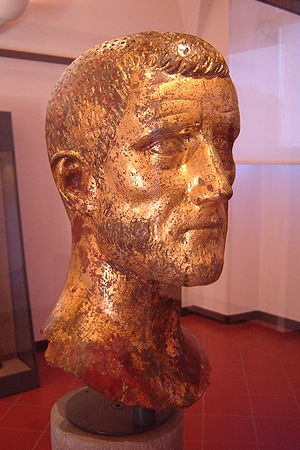I was recently asked by Cambridge University Press to review "Rome's Gothic Wars: From the Third Century to Alaric (Key Conflicts of Classical Antiquity) by Michael Kulikowski. I finally got a chance to begin reading it and find it clearly written and thankfully devoid of the stilted academic jargon that pervades many history texts. As most
of my studies have focused on the Roman Republic, I am learning all kinds of fascinating things about this later period.
For example, I did not realize that there were reports of cannibalism
inside the city of Rome during Alaric's siege. Kulikowski also postulates that one of the stimuli for the beginning of Gothic invasions of the Empire was in response to Caracalla's granting of citizenship to all free residents of the empire. He felt that this action opened up the possibilities for anyone - not just provincial
elites who had gained senatorial rank - to gain the throne.
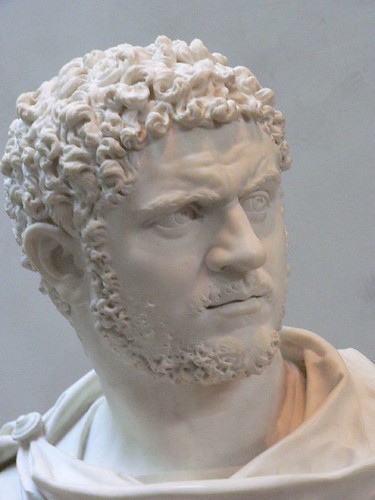 |
| Cavaceppi's 18th century portrait of 2nd century CE Roman Emperor Caracalla photographed at the J. Paul Getty Museum in Los Angeles, CA by Mary Harrsch © 2005 |
He also went on to describe the problems created by Roman interference in Barbarian tribal control with Roman subsidy of particular tribal leaders. Although this may have brought temporary loyalty, ultimately it garnered a larger core of support around these subsidized chieftains who would then be in a position to challenge the authority of Rome itself along the frontiers. He pointed out that Decablus was just such an example. The Romans initially subsidized his power base in Dacia.
I found an article that described how this came about:
"In 60 BC, King Burebista of Dacia began a series of expansionistic moves to relieve pressure from nomadic incursions, which eventually threatened Roman Danubian and Black Sea territories. Julius Caesar began to lay plans for a campaign in Dacia and Partha, which came to naught when both Caesear and Burebista were assassinated in 44 BC. Later, during the reign of Nero (54-68 AD), Dacian raids into Roman Moesia became so serious that the Romans engaged the Roxolani to help defend their frontier, thus placing Dacia's sometime Sarmatian allies on their enemies list.
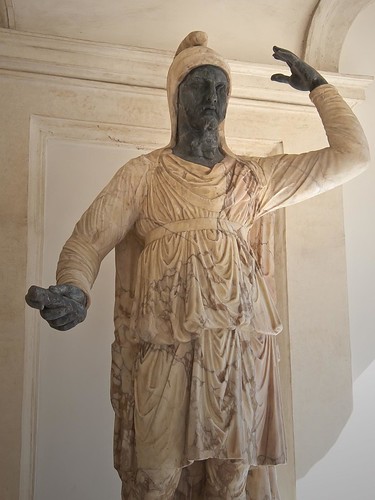 |
| Colossal statue of a Dacian Roman 2nd century CE photographed at the Palazzo Altemps, Rome, Italy by Mary Harrsch © 2009 |
In 85 AD, King Decebalus assumed the Dacian throne, adopting a hostile Roman policy that posed a serious challenge to the Emperor Domitian (81-96 AD). A Dacian army raided across the Danube into the Roman province of Moesia, killing the Roman governor and looting the
countryside. This prompted an retaliatory expedition under command of praetorian prefect Cornelius Fuscus that was wiped out in eastern Dacia (including the loss of Legio V Alaudae) . A second Roman expedition was severely defeated in 87 AD.
Finally, a Roman army under Tettius Julianus defeated the Dacians at Tapae in 88 or 89 A.D. King Decabalus of Dacia was forced to pay tribute and allow Roman armies passage through Dacian territory. Domitian, however, was distracted by Saturninus' Revolt on the Rhine Frontier and uprisings by the Sarmatian Iazyges, Marcomanni and Quaid tribes on Rome's Pannonian frontier. He sought the favor of Decabalus to avoid a Dacian-Sarmatian alliance, offering skilled artisans and hostages to ensure Dacian neutrality while he contended with his other headaches." - DBA Resource, Fanaticus.org
I couldn't help but think that we certainly didn't learn much from these Roman experiences in political interference since we so recently repeated their mistakes!
Kulikowski, also pointed out something that is important to know if you are reading original historical sources from the period. He says that, even though the Goths contemporaries referred to them as Goths,
historical scholars of the day used the formal designation "Scythians" because the Goths had originated north of the Black Sea in the same region once occupied by the true Scythians recorded by Herodotus.
I also found little controversies pointed out by Michael Kulikowski quite interesting. He appears to be very skeptical of Jordanes narrative of the origin and migration of the Goths from Scandanavia to the Black Sea region ("Getica"). Supposedly, Jordanes sixth century account was based on the lost barbarian histories by Cassiodorus. But Kulikowski maintains that Jordanes work was prepared while attached to the court of
Theodoric so he feels it was meant to provide a glorious history of descent for that monarch and can't be solely relied upon when no other sources are available - much like the skepticism that always surrounds
the narratives by Suetonius.
He went on to say that the connection between the Goths and Scandanavia has been disproved archaeologically but did not elaborate on how. He feels the Goths arose as a result of barbarian
relationships with the Roman army along the frontiers in the third century and that they did not exist as a recognizable cultural group before that time.
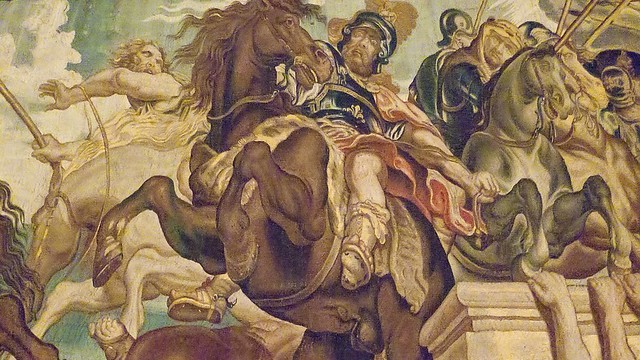 |
| Detail of a tapestry by Peter Paul Reubens depicting Constantine's victory over Maxentius at the battle of the Milvian Bridge in 312 CE photographed at the Philadelphia Museum of Art in Philadelphia, PA by Mary Harrsch© 2011 |
Kulikowski, also observed that Constantine apparently deliberately shifted from the former emperors' claims to be descended from Hercules to claim a descent from Claudius Gothicus. The author seemed to think this was a way to demonstrate a rejection of pagan philosophies. Richard D. Weigel of Western Kentucky University seems to support the observation that any connection with Claudius Gothicus was a fiction:
"M. Aurelius Claudius, known to history as Claudius Gothicus or Claudius II, was born in either Dalmatia or Illyria on May 10, probably in A.D. 213 or 214, " Wiegel says, "Although the most substantive source on Claudius is the biography in the Scriptores Historiae Augustae (SHA), this account is riddled with fabrications and slanted with fawning praise for this particular emperor, who in the fourth century was viewed as an ancestor of Constantine's father and thus of the ruling imperial family. This biography, attributed to one Trebellius Pollio, must be read with extreme caution and supplemented with information from other sources, including Aurelius Victor, the Epitome de Caesaribus, Eutropius, Orosius, Zonaras, and Zosimus, as well as coins and inscriptions." - De Imperatorabus Romanis
| The first one of the two twin bronze busts of Claudius II "the Gothic" (268/269 d.C.). The gilded bronze portraits, five of Roman emperors and one of an empress, were hidden beneath the Capitoline temple in Brescia, together with other bronze objects, to prevent the consequences of a possible sack of the town in the 4th or 5th century, and unearthed only in 1826. They are now exhibited in the archaeological Santa Giulia Museum, in Brescia, Italy. (Photo credit: Wikipedia) |
Although his reign was short, Claudius Gothicus did appear to be an emperor worth emulating:
"The Gothic challenge in 269 CE proved to be the greatest that Claudius II would face. The Goths assembled a large invading force, reportedly amounting to 320,000 men transported on a fleet of at least 2,000 ships, and first attacked coastal cities along the Black Sea in Moesia. After passing into the Aegean the Goths besieged Thessalonica. At this point, in 269, Claudius left Rome to stop the invasion. The Goths then sent the larger segment of their troops on land toward the Danube, while the fleet took the remaining group to continue the naval attack on Aegean coastal cities. Claudius sent Aurelian's cavalry to Macedonia to protect Illyria from attack, while he commanded the forces blocking the route to the Danube. In the area of Doberus and Pelagonia, the Goths lost 3,000 men to Aurelian's cavalry. At Naissus in Moesia, Claudius' force succeeded in killing some 50,000 Goths. There were follow-up operations on both land and sea, but the Gothic War had essentially been won. Staving off the attacks of the Goths was a major contribution to the survival of the Roman Empire. It was a significant step leading to the subsequent success of Aurelian and the resurrection of the Empire under Diocletian and Constantine. When the Goths eventually succeeded in taking parts of the western Empire in the fifth century, their disruption to the course of civilization was likely much less violent than it would have been had they succeeded in the third century.<
 |
| Detail of the Ludovisi sarcophagus thought to depict a battle between the Romans and the Goths 2nd - 3rd century CE photographed at the Palazzo Altemps in Rome, Italy by Mary Harrsch © 2009 |
In addition to bad weather, a lack of supplies, and hunger, plague was a major factor in the defeat of the Goths. Many of the Gothic prisoners were either impressed into Roman military service or settled on farms as coloni. Claudius received the title Gothicus in recognition of his triumph over the Goths. At some point he had also been given the title Parthicus, but the unlikelihood of any conflict with the Parthians in his short reign makes this difficult to explain. Perhaps Damerau was correct in his suggestion that a Parthian unit may have been involved in one of the battles with the Palmyrenes, although on this front there were few achievements to claim. In any case, Claudius' victory over the Goths was short-lived. The emperor himself caught the plague and died at Sirmium early in 270. He was 56 years old Claudius' brother, Quintillus, became emperor briefly before losing out to Aurelian. Claudius also had another brother, Crispus, and the SHA traces the link to Constantius through Crispus' daughter Claudia.
The Roman Senate showed its respect for Claudius Gothicus by setting up a gold portrait-shield in the Curia and by approving his deification. He was also honored with a golden statue in front of the great temple of Jupiter Optimus Maximus and a silver statue set on a column on the Rostra." - WikipediaAll of these issues prompted me to seek out other academic opinions and more information.
Judith Weingarten, who studied classical archaeology at Oxford and is a member of the British School of Athens, disagreed with Kulikowski's suggestion that Caracalla's granting of citizenship to all free residents was a crucial trigger to the Gothic migrations:
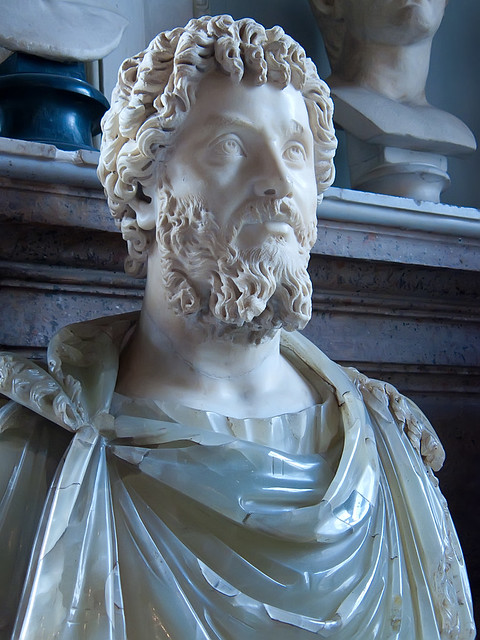 |
| Bust of the Roman emperor Septimius Severus photographed at the Capitoline Museum in Rome, Italy by Mary Harrsch © 2009 |
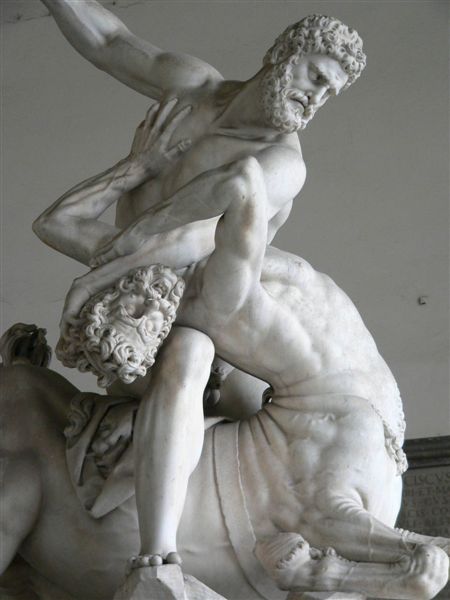 |
| Hercules battling the centaur Nessus by by Giovanni Bologna 1599 CE photographed at the Palazzo Vechio in Florence, Italy by Mary Harrsch © 2005 |
"In my opinion," she continues, "the true reason for Caracalla granting citizenship to all free men in the Empire, was his need to raise revenue: in return for citizenship, he taxed them. When even that was insufficient, he debased the currency...."
Another historian, Volker Carlton Bach of Denmark, took issue with the speculation that Constantine's rejection of the emperor's traditional descent from Hercules was a demonstration of rejection of pagan philosophy.
"I think this is based on a misunderstanding," Bach states, "The descent of the Herculian Emperors (not the Jovian ones) from Hercules was purely a notional, cultic (for want of a better word) concept. The closest we have today, I think, is the link between the popes and St Peter - not an arogation of genetic descent, but a claim of spiritual successorship and close association. The Romans knew that Maximian and his successors were not the great-great-great-repeat ad nauseam-grandsons of the heros Hercules. After all, they had real mothers and fathers, and in some cases even knew both with a degree of certainty. The descent claim from Claudius Gothicus, on the other hand, *is* a 'real' paternity claim, similar to the adoption of Antonine nomenclature by third-century emperors. So Constantine doesn't really replace one claim with another. The Herculian designation was unnecessary simply because with Constantine's victories, as it had been used to distinguish junior colleagues from senior (Jovian) ones. Constantine was *the* emperor, so that was that. Claudius Gothicus, on the other hand, was a very attractive ancestor to claim, a successful and legendary warrior and, unlike Aurelian or Diocletian, without anti-Christian baggage."
Any book that can generate this type of quality discussion is a worthy addition to any history enthusiast's collection. I notice it is one of a series of introductory-level texts exploring the key conflicts of classical antiquity. I look forward to reading others in this series.
Related articles
 |
 |
 |
 |
